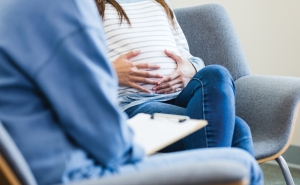Analysis Suggests 2021 Texas Abortion Ban Resulted in Nearly 9,800 Extra Live Births in State In Year After Law Went Into Effect
Researchers use statistical modeling to estimate the number of live births expected if one of the country’s most stringent state abortion laws had not been enacted.

In a peer-reviewed research letter published online today in JAMA, researchers from the Johns Hopkins Bloomberg School of Public Health estimate that a Texas abortion ban that went into effect in September 2021 was associated with 9,799 additional live births in the state between April and December 2022.
The measure, Texas Senate Bill 8, banned abortions as early as five weeks after the start of a patient’s last menstrual cycle—effectively banning abortion in the state, with very limited exceptions. Previously, Texas had allowed abortions up to 22 weeks gestation for any indication.
Researchers expect the number of abortion procedures to drop and live births to increase when abortion restrictions go into effect within a state, but do not know to what extent for some time. A 2022 study, also published in JAMA, estimated that abortions provided to pregnant Texas residents in facilities in Texas or in one of six adjacent states decreased by 38 percent—2,171 fewer abortions—in the month after the Texas abortion ban went into effect.
The new study is thought to be the first to examine how the Texas abortion ban may have impacted live births in the state.
“There has been a lot of speculation about how restrictive abortion policies will affect the number of babies being born. This research adds valuable information to that discussion,” says Alison Gemmill, PhD, assistant professor in the Bloomberg School’s Department of Population, Family and Reproductive Health and one of the study’s lead authors. “Although our study doesn't detail why these extra births occurred, our findings strongly suggest that a considerable number of pregnant individuals in Texas were unable to overcome barriers to abortion access.”
For their analysis, the researchers used statistical modeling to create a “synthetic” Texas based on monthly live birth data from all 50 states and Washington, D.C., from 2016 through 2022. The researchers calculated that there would have been 287,289 live births in Texas from April to December 2022 had the abortion ban not gone into effect in September 2021. The number of observed births during this period was 297,088, a difference of 9,799.
“The study’s findings highlight how abortion bans have real implications for birthing people, thousands of whom may have had no choice but to continue an unwanted or unsafe pregnancy to term,” says Suzanne Bell, PhD, MPH, assistant professor in the Bloomberg School’s Department of Population, Family and Reproductive Health and one of the study’s lead authors. “Notably, the majority of people who seek abortions live below or close to the poverty line. So many of these birthing people and their families were likely struggling financially even before the recent birth.”
The findings come one year after the U.S. Supreme Court overturned Roe v. Wade in its landmark Dobbs decision and as more states move to enact abortion restrictions. Separately, a federal lawsuit likely to end up before the U.S. Supreme Court is challenging the Food and Drug Administration’s approval of mifepristone, one of two pills used in most medication abortions. Though mifepristone is still available, the case casts uncertainty over the reproductive rights landscape.
The authors note that the results cannot be generalized, as the analysis was restricted to one state.
The researchers will explore how the Texas law may have disproportionately impacted certain demographic groups when detailed birth data become available in the coming months.
The study was supported by a grant from the National Institute of Child Health and Human Development (P2CHD042854).
Disclosure: Alison Gemmill reported receiving consulting fees from Population Reference Bureau outside the published work.
“Texas’ 2021 Ban on Abortion in Early Pregnancy and Changes in Live Births” was written by Suzanne O. Bell, Elizabeth A. Stuart, and Alison Gemmill.
# # #
Media contacts: Kristine Henry kristine.henry@jhu.edu and Barbara Benham bbenham1@jhu.edu





